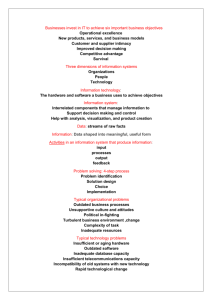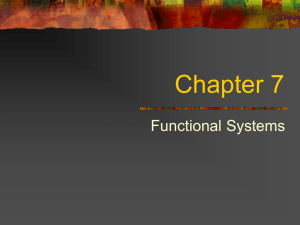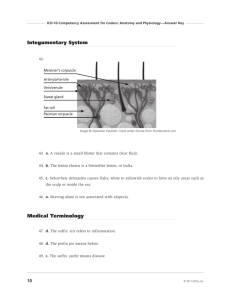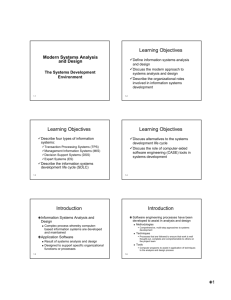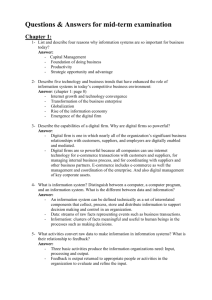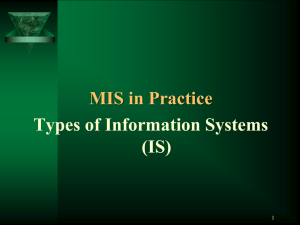乐档网,我分享,我快乐! http://www.ledlh.cn/ 本文档下载自乐档网,更
advertisement
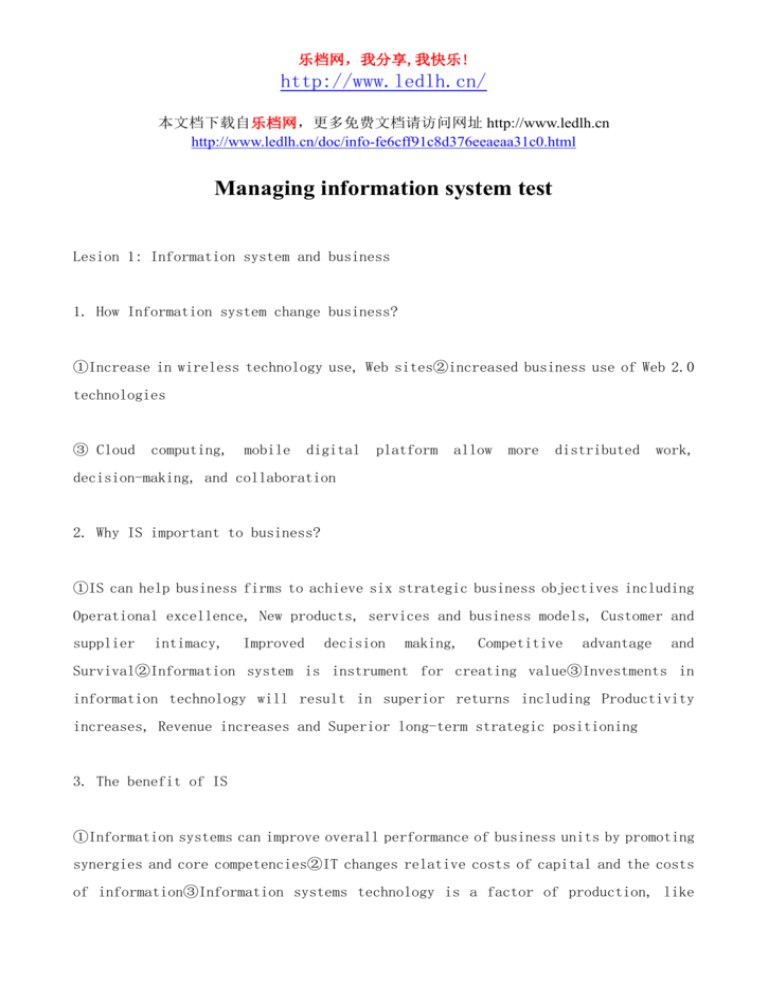
乐档网,我分享,我快乐! http://www.ledlh.cn/ 本文档下载自乐档网,更多免费文档请访问网址 http://www.ledlh.cn http://www.ledlh.cn/doc/info-fe6cff91c8d376eeaeaa31c0.html Managing information system test Lesion 1: Information system and business 1. How Information system change business? ①Increase in wireless technology use, Web sites②increased business use of Web 2.0 technologies ③ Cloud computing, mobile digital platform allow more distributed work, decision-making, and collaboration 2. Why IS important to business? ①IS can help business firms to achieve six strategic business objectives including Operational excellence, New products, services and business models, Customer and supplier intimacy, Improved decision making, Competitive advantage and Survival②Information system is instrument for creating value③Investments in information technology will result in superior returns including Productivity increases, Revenue increases and Superior long-term strategic positioning 3. The benefit of IS ①Information systems can improve overall performance of business units by promoting synergies and core competencies②IT changes relative costs of capital and the costs of information③Information systems technology is a factor of production, like 乐档网,我分享,我快乐! http://www.ledlh.cn/ capital and labor④IT affects the cost and quality of information and changes economics of information⑤IT lowers market transaction costs for a firm, making it worthwhile for firms to transact with other firms rather than grow the number of employees⑥IT can reduce agency costs, making it possible for firms to grow without adding to the costs of supervising, and without adding employees. 4. Define an information system and describe the activities it performs ① IS consists of Set of interrelated components, Collect, process, store, and distribute information and Support decision making, coordination, and control②Main activities: Input, Processing and Output. Different from raw data and computer or computer program. Using information systems effectively requires an understanding of the organization, management, and information technology shaping the systems. An information system creates value for the firm as an organizational and management solution to challenges posed by the environment. Lesion 2 various systems 1. how IS enhance business? Increasing efficiency of existing processes and Enabling entirely new processes that are capable of transforming the businesses 2. TPS: supporting operational level employees and Major source of data for other systems(differ from other system) Perform and record daily routine transactions necessary to conduct business Allow managers to monitor status of operations and relations with external environment Serve operational levels 乐档网,我分享,我快乐! http://www.ledlh.cn/ Serve predefined, structured goals and decision making 3. MIS: supporting managers Serve middle management Provide reports on firm’s current performance, based on data from TPS Provide answers to routine questions with predefined procedure for answering them Typically have little analytic capability 4. DSS: supporting managers Serve middle management Support non-routine decision making Often use external information as well from TPS and MIS Model driven DSS, such as Voyage-estimating systems Data driven DSS, such as Intrawest’s marketing analysis systems 5. ESS: supporting executives and Recipient of data from lower-level systems Support senior management Address non-routine decisions 乐档网,我分享,我快乐! http://www.ledlh.cn/ Incorporate data about external events (e.g. new tax laws or competitors) as well as summarized information from internal MIS and DSS 6. The importance of enterprise applications Coordination of daily activities Efficient response to customer orders (production, inventory) Provide valuable information for improving management decision making Lesion 3 1. Features of organization.①Use of hierarchical structure ②Accountability, authority in system of impartial decision making③Adherence to principle of efficiency④Routines and business processes⑤Organizational politics, culture, environments and structures⑥Goals⑦Leadership styles⑧Tasks⑨Surrounding environments 2. Organizational environments Organizations and environments have a reciprocal relationship Organizations are open to, and dependent on, the social and physical environment Organizations can influence their environments Environments generally change faster than organizations Information systems can be an instrument of environmental scanning, act as a lens 乐档网,我分享,我快乐! http://www.ledlh.cn/ 3. The impact of Disruptive technologies and internet Technology that brings about sweeping change to businesses, industries, markets, such as personal computers, word processing software and the Internet. The Internet increases the accessibility, storage, and distribution of information and knowledge for organizations The Internet can greatly lower transaction and agency costs 4. Internet has changed competitive forces and competitive advantage ①Transformation, destruction, threat to some industries, such as travel agency, printed encyclopedia, newspaper ②Competitive forces still at work, but rivalry more intense③Universal standards allow new rivals, entrants to market ④New opportunities for building brands and loyal customer bases 5. Four competitive strategies enabled by IS Low-cost leadership: Produce products and services at a lower price than competitors while enhancing quality and level of service, Wal-Mart Product differentiation: Enable new products or services, greatly change customer convenience and experience, Google, Nike, Apple Focus on market niche: Use information systems to enable a focused strategy on a single market niche; specialize, Hilton Hotels 乐档网,我分享,我快乐! http://www.ledlh.cn/ Strengthen customer and supplier intimacy: Use information systems to develop strong ties and loyalty with customers and suppliers; increase switching costs, Amazon. Lesion 4 1. Key technological trends that heighten ethical concerns ① Doubling of computer power②Rapidly declining data storage costs③Networking advances and the Internet ④Advances in data analysis techniques 2. Basic concepts for ethical analysis Responsibility, Accountability, Liability and Due process 3. How the Internet challenges the protection of individual privacy and intellectual property Cookies: Allow Web sites to develop profiles on visitors Web beacons/bugs: Web pages to monitor who is reading message Spyware: Surreptitiously installed on user’s computer 4. Challenges to intellectual property rights Digital media different from physical media, including ①Ease of replication, ②Ease of transmission, ③Difficulty in classifying software④Difficulties in establishing 乐档网,我分享,我快乐! http://www.ledlh.cn/ uniqueness 5. Three main ways to protect intellectual property Trade secret: Intellectual work or product belonging to business, not in the public domain Copyright: Statutory grant protecting intellectual property from being copied for the life of the author, plus 70 years Patents: Grants creator of invention an exclusive monopoly on ideas behind invention for 20 years Lesion 5 IT infrastructures 1. IT infrastructure includes: Set of physical devices and software required to operate enterprise Set of firm-wide services including Telecommunications services, Data management services and Application software services “Service platform” perspective more accurate view of value of investments 2. IT Infrastructure has 7 main components 1.Computer hardware platforms 乐档网,我分享,我快乐! http://www.ledlh.cn/ 2.Operating system platforms 3.Enterprise software applications 4.Data management and storage 5.Networking/telecommunications platforms 6.Internet platforms 7.Consulting system integration services 3. Cloud computing and its advantages and disadvantages Advantage: On-demand (utility) computing services obtained over network such as Infrastructure as a service, Platform as a service and Software as a service Cloud can be public or private Allows companies to minimize IT investments Disadvantage: Concerns of security, reliability 4. Current trends in computer hardware and software platforms Hardware: Client machines, Servers, Mainframes, Top chip producers and Top firms Software: open-source software, software outsourcing 乐档网,我分享,我快乐! http://www.ledlh.cn/ Lesion 6-7 enterprise system, supply chain and application 1. BI Business Intelligence (BI) is the use of information systems to gather and analyze information from internal and external sources in order to make better business decisions. Class of software applications Analyze current and historical data to find patterns and trends and aid decision-making Used in systems that support middle and senior management, such as Data-driven DSS Tools for consolidating, analyzing, and providing access to vast amounts of data to help users make better business decisions 2. Enterprise systems help businesses achieve operational excellence ① Increase operational efficiency②Provide firm-wide information to support decision making③Enable rapid responses to customer requests for information or products④Include analytical tools to evaluate overall organizational performance 3. How does supply chain management systems involve planning, production, and logistics with suppliers? Process: ①Procuring raw materials②Transforming them into products③Distributing the products importance: ?Match supply to demand?Reduce inventory levels?Improve delivery 乐档网,我分享,我快乐! http://www.ledlh.cn/ service?Speed product time to market?Use assets more effectively?Reduced supply chain costs?Increased sales 4. How do customer relationship management systems help firms achieve customer intimacy? Boosting customer retention Enhancing and optimizing customer retention and loyalty is a primary objective of CRM Identify, reward, and market to the most loyal and profitable customers Evaluate targeted marketing and relationship programs 5. Business value of customer relationship management ?Increased customer satisfaction ?Reduced direct-marketing costs ?More effective marketing ?Lower costs for customer acquisition/retention ?Increased sales revenue ?Reduced churn rate 6. The challenges posed by enterprise applications 乐档网,我分享,我快乐! http://www.ledlh.cn/ Highly expensive to purchase and implement enterprise applications – total cost may be 4 to 5 times the price of software Requires fundamental changes such as Technology changes, Business processes changes and Organizational changes Incurs switching costs, dependence on software vendors Requires data standardization, management, cleansing Lesion 8 knowledge management 1. Knowledge management Set of business processes developed in an organization to create, store, transfer, and apply knowledge 2. Enterprise management systems Help capture, store, retrieve, distribute, preserve Bring in external sources Tools for communication and collaboration 乐档网,我分享,我快乐! http://www.ledlh.cn/ 3. What knowledge management systems can do or importance? Provide tools for management, delivery, tracking, and assessment of various types of employee learning and training Support multiple modes of learning Automates selection and administration of courses Assembles and delivers learning content Measures learning effectiveness 乐档网-提供各行各业及小学、初中、高中、高等教育、工程科技、工程管理、 职场、商业合同等文档范文下载,所有范文免费分享,是您下载范文的首选网 站。 乐档网 http://www.ledlh.cn/


